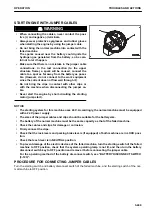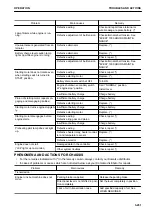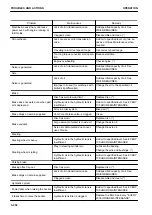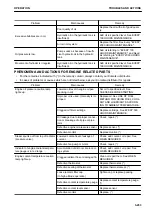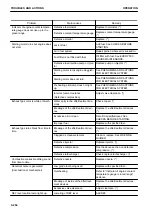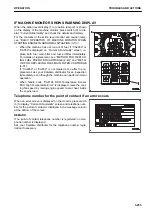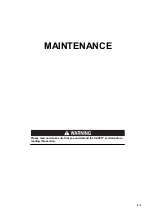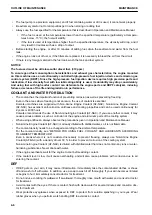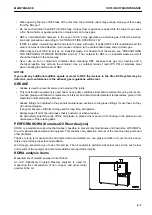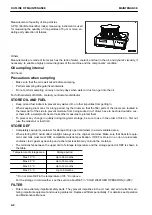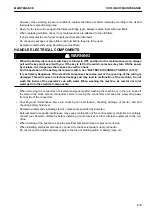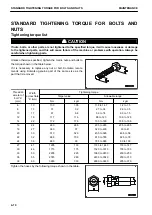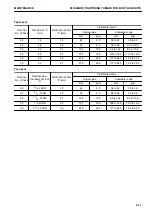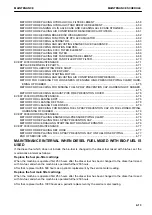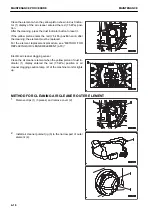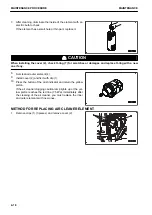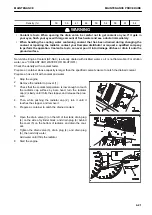
• The fuel pump is a precision equipment, and if fuel containing water or dirt is used, it cannot work properly.
• Be extremely careful not to let impurities get in when storing or adding fuel.
• Always use the fuel specified for the temperature that is described in Operation and Maintenance Manual.
• If the fuel is used at the temperatures lower than the specified temperature (particularly at tempera-
tures below -15 °C), the fuel will solidify.
• If the fuel is used at temperatures higher than the specified temperature, the viscosity will drop, and it
may result in troubles such as a drop of output.
• Before starting the engine, or after 10 minutes of adding fuel, drain the sediment and water from the fuel
tank.
• If the engine runs out of fuel, or if the filters are replaced, it is necessary to bleed the air from the circuit.
• If there is any foreign material in the fuel tank, wash the tank and fuel system.
NOTICE
The fuel used must be ultra low-sulfur diesel fuel. (≤10 ppm)
To ensure good fuel consumption characteristics and exhaust gas characteristics, the engine mounted
on this machine uses an electronically controlled high-pressure fuel injection device and emission gas
control system (KDPF). Since the high-pressure fuel injection device requires high precision parts and
lubrication, if low viscosity fuel with low lubricating ability is used, its durability may drop considerably.
And using fuel with high sulfur content can deteriorate the engine parts and KDPF catalyzer, inducing
failures, decrease of the life and degradation in performance.
COOLANT AND WATER FOR DILUTION
• The coolant has the important function of preventing corrosion as well as preventing freezing.
Even in the areas where freezing is not an issue, the use of coolant is essential.
Komatsu machines are supplied with Non-Amine Engine Coolant (AF-NAC). Non-Amine Engine Coolant
(AF-NAC) has excellent anti-corrosion, antifreeze and cooling properties and can be used continuously for
2 years or 4000 hours.
Komatsu recommends the use of Non-Amine Engine Coolant (AF-NAC). If you use another coolant, it may
cause serious problems, such as corrosion of the engine and aluminum parts of the cooling system.
• When using antifreeze, always observe the precautions given in Operation and Maintenance Manual.
• Non-Amine Engine Coolant (AF-NAC) is already diluted with distilled water, so it is not flammable.
• The coolant density needs to be changed according to the ambient temperature.
For the coolant density, see “METHOD FOR USING FUEL, COOLANT AND LUBRICANTS ACCORDING
TO AMBIENT TEMPERATURE”.
Even in areas where it is not considered necessary to prevent freezing, always use Non-Amine Engine
Coolant (AF-NAC) with a density of over 30 % in order to prevent corrosion of the cooling system.
Non-Amine Engine Coolant (AF-NAC) is diluted with distilled water that does not contain any ions or water-
hardening substances. Never dilute with water.
• If the engine overheats, wait for the engine to cool before adding coolant.
• If the coolant level is low, it will cause overheating, and will also cause problems with corrosion due to air
entering the coolant.
DEF
• If DEF gets on your skin, it may cause inflammation. Immediately take the contaminated clothes or shoes
off and wash it off with water. In addition, use a soap to wash it off thoroughly. If your skin becomes irritated
or begins to hurt, immediately consult a doctor for treatment.
• Do not induce vomiting if swallowed. If swallowed, thoroughly rinse mouth with water and consult a doctor
for treatment.
• Avoid contact with the eyes. If there is contact, flush with clean water for several minutes and consult a doc-
tor for treatment.
• Wear protective eyeglasses when exposed to DEF to protect from solution splashing in your eyes. Wear
rubber gloves when you perform work handling DEF to avoid skin contact.
OUTLINE OF MAINTENANCE
MAINTENANCE
4-6
Summary of Contents for WA480-8
Page 2: ......
Page 19: ...Distributor name Address Phone Fax Service personnel FOREWORD PRODUCT INFORMATION 1 17...
Page 29: ...LOCATION OF SAFETY LABELS SAFETY SAFETY LABELS 2 3...
Page 159: ...SWITCHES 1 ECSS switch 2 Front working lamp switch OPERATION EXPLANATION OF COMPONENTS 3 91...
Page 302: ...Securing position Fixing angle A 61 B 53 C 33 D 38 TRANSPORTATION OPERATION 3 234...
Page 324: ......
Page 397: ...Viewed from the rear side of the machine MAINTENANCE MAINTENANCE PROCEDURE 4 73...
Page 402: ......
Page 403: ...SPECIFICATIONS 5 1...
Page 406: ......
Page 422: ......
Page 423: ...REPLACEMENT PARTS 7 1...
Page 439: ......


